
INTRODUCTION METHODS
Vietnamese HLL and Vocabulary Learning
Leon Potter
University of Hawaii at Manoa, College of Education
INTRODUCTION
Vocabulary learning is one of the most fundamental and basic
challenges in the task of learning an additional language. For
heritage learners, vocabulary poses subtle challenges that are
easily misinterpreted or misjudged. In this research I examined how
heritage students enrolled in a 2nd year Vietnamese class at the
University of Hawaii at Manoa negotiated their vocabulary learning
needs. In addition, I asked them to explain why they thought
certain vocabulary was difficult to learn. I accomplished this
through interviews of students and the Vietnamese language
instructor, professor Tran*, as well as used a survey of all of the
heritage learners in the 2nd year class over the last 6 years (n= 69).
Through this research I hope to help language learners and language
teachers better understand what techniques and methods heritage
students utilize to acquire their new vocabulary, in general, and for
Vietnamese vocabulary, specifically.
*Personal names have all been changed.
DEFINITIONS & LITERATURE
Heritage Language Learners
The term heritage learner can be narrowly defined as “a student
who is raised in a home where non-English language is spoken, who
speaks or merely understands the heritage language, and who is to
some degree bilingual in English and the heritage language”
(Valdés, 2000, p. 1). Heritage learners are those students who have
some linguistic ability with the language. Furthermore, it has been
clearly shown, in a Japanese language context, that not all heritage
language student’s knowledge are the same. Kondo-Brown (2005)
showed that students that had only grandparents who spoke the
target language had essentially the same language abilities as a
non-heritage learner. In contrast, students who had at least one
parent that spoke the target language with the student had
significantly different abilities than the other language learners. It
is these learners, the ones with significantly different abilities than
other language learners, who are the subjects of this research.
Learning Vocabulary
A learner's approach to vocabulary learning or study is defined as a
learner's study habits for learning new words or phrases.
Studies have demonstrated that peer work or collaboration can
have benefits for vocabulary building (Horst, Cobb, & Nicolae,
2005; Jones, 2006). While other research has demonstrated that
student effort trying to figure out a vocabulary word correlates
with how well they tend to retain it (Loucky, 2006). Sanaoui (1995)
had learners self-report their vocabulary learning process they were
“using dictionaries, memorizing lists of words, making up word
charts, practicing words, learning words in context, repeating
words, using mental imagery, and reviewing previously learned
words” (p. 16).
Godwin-Jones (2010) correctly stated that as learners advance they
tend to learn from less formal sources, such as “reading or
listening, deciphering unknown expressions through their contextual
use, root meaning, structure, or similarity to known items, or by
simply looking them up in a reference work” (p. 4). The keyword
method uses graphics as an aid. It has a two-step process: first
finding an L1 (first language) word which sounds similar to the
pronunciation of the L2 (second language) item to be learned, then
associating an image or story, then associating an image or story
with both the meaning of the word and the keyword used to
approximate its pronunciation. There has been considerable
research on the keyword technique (Nation, 2001). Bahr and
Dousereau (2001), discuss concept mapping in language learning.
RESEARCH POSTER PRESENTATION DESIGN © 2012
www.PosterPresentations.com
METHODS
CONCLUSIONS
This research is a qualitative project using traditional ethnographic tools: surveys, interviews, observations, and institutionally produced
documents. I justify the use of ethnographic tools because at the start of this project I cast my “research net” as wide as possibly in the hopes of
finding something interesting in the Vietnamese classes. I “inductively built” the questions, issues, and ideas from the data gathered. This
research began, without the desire to “test concepts, hypotheses, and theories” (Merriam, 1998, p. 45), but to develop a nuanced and deep
understanding about a specific aspect of Vietnamese heritage language learners who are studying Vietnamese at university level.
Surveys
The perspectives of all the students were gathered through the researcher’s survey that were administered in the second semester of the second
year class (April/May of the 202-level class). Students typically took 10 to 20 minutes to fill out the survey depending on the amount of detail they
chose to write in the open-ended questions. The survey was created by the researcher with 2 years of piloting and adjusting this research tool.
Interviews
Students volunteered to participate in the interview through the researcher’s survey tool (it is the last question on the survey). I contacted the
students through the contact information that they provide. I conducted the interviews and recorded them with a digital recorder and then
transcribed the interviews. The interviews were then analyzed to discover recurring ideas, which were then used in future interviews. As a result,
interviews throughout this research were evolving and necessarily different from one another.
Observations
Through out the academic school year, I sat in on the Vietnamese 201 and 202 classes taking notes about the class on themes and topics that
include: the different teaching activities used in the class and how the students have reacted to these activities, the overall engagement of the
students with the lessons, as well as, the students’ preparation prior to the lessons. These observations were used to triangulate responses on the
survey and through the interviews.
Documents
In some aspects, triangulation of the above data was done through the examination of institutionally generated documents created for the
language department and filled out by the students once per semester through an online survey called “e-café.” This online survey was designed
to evaluate the language instructor and the language class materials with predictable questions based on the likes and dislikes of the students for
the instructor and the course. This data was used when it was in agreement with, and especially when it was in disagreement with, the other data
sources.
RESULTS
The results from the open-ended questions best answer the two research questions. First, in answering how do you study new vocabulary? The
majority, or 21 students, responded with repeated writing, the next most popular technique was “read” by 10 students. Using flash cards or index
cards and the rather generic response of “memorize” each had 8 students, while 7 students mentioned doing something orally (such as read out
loud, or say it over and over). Some of the less common but still noteworthy responses were: ask my dad, make a “fake” test, finding an English
equivalent, and make a spread sheet, which each had 2 or 3 respondents.
In the same open-ended questions section, students were asked what makes new vocabulary difficult? The majority, or 22 students, responded
with a variation of if I haven’t heard it before. Nearly as many, 17 students, felt that the tone marks or accents made the vocabulary the most
difficult. 6 students mentioned the inability pronounce new words as a challenge to learning.5 students felt that when a vocabulary word was not
thought to be useful, students had a hard time learning it. Finally, 2 students said that if a word had too many synonyms they were hard to learn.
How to Study Vocab
What makes Vocab difficult
25
25
20
20
15
15
10
5
10
5
0
0
I have attempted to show that heritage learners in 2nd year
Vietnamese class have unique vocabulary learning needs. Their
heavy exposure to the Vietnamese language as they are growing up
influences their pronunciation and vocabulary knowledge. These
students tend to struggle because the dialect they know is different
from the dialect used in the Vietnamese language class. Based on
interviews and survey of the heritage students I hope to have shed
some light on the needs and thoughts of these students. Because
the survey used open-ended questions the heritage language
learners were able to explain what they did to learn their new
Vietnamese vocabulary without influence from the researcher. The
majority of these learners use techniques that Sanaoui (1995)
described as structured. Meaning they used self-created
opportunities in and out of the classroom and were independently
motivated to create their own study options with less reliance on
the course to offer these opportunities. It would be beneficial to
build upon these techniques and encourage or promote them
through the curriculum.
REFERENCES
Bahr, G. S., & Dansereau, D. F. (2001). Bilingual knowledge maps
(BiK-Maps) in second-language vocabulary learning. The Journal of
Experimental Education, 70(1), 5–24.
Godwin-Jones, R. (2010). Emerging technologies from memory
palaces to spacing algorithms: Approaches to second-language
vocabulary learning. Language Learning & Technology, 14(2), 4–11.
Horst, M., Cobb, T., & Nicolae, I. (2005). Expanding academic
vocabulary with an interactive on-line database. Language Learning
& Technology, 9(2), 90–110.
Jones, L. (2006). Effects of collaboration and multimedia
annotations on vocabulary learning and listening comprehension.
CALICO Journal, 24(1), 33–58.
Kondo-Brown, K. (2005). Differences in Language Skills: Heritage
Language Learner Subgroups and Foreign Language Learners, The
Modern Language Journal, 89(4), 563-581.
Loucky, J. (2007). Maximizing vocabulary development by
systematically using a depth of lexical processing taxonomy, CALL
resources, and effective strategies. CALICO Journal, 23(2), 363–
399.
Nation, P. (2001). Learning vocabulary in another language.
Cambridge: Cambridge University Press.
Sanaoui, R. (1995). Adult Learners' Approaches to Learning
Vocabulary in Second Languages. The Modern Language Journal,
79(1), 15-28.
Merriam, S.B. (1998). Qualitative research and case study
applications in Education. San Francisco, CA: Jossey-Bass.
Valdés, G. (2000). Introduction. Spanish for Native Speakers,
Volume I. AATSP Professional Development Series Handbook for
teachers K-16. New York: Harcourt College.
ACKNOWLEDGEMENTS
In her interview, *Tri felt that writing was the most challenging because she said “I know how to say a word but I don’t know how to write or spell
the word correctly.” She also felt that writing seemed to be more formal, meaning it uses words for which she is less familiar. Interestingly, Tri
prioritized the importance of reading. She said “reading is more important because I came to the [Vietnamese] class knowing how to speak, but
didn’t know how to read or write.” However, reading for her was more important because she felt that she would use reading outside of class
more than she would use writing.
In Duc’s interview he mentioned the language instructor as a reference “*Tran even helps me learn the southern equivalent for every word in the
vocab lists. And just like I said earlier, the first time I went to {teacher’s name] class in 101 I was very hesitant to believe everything said was true
because I wanted to hold on to everything I learned from my parents and my past experience, but at the same time I kind of let it slide and
started absorbing what [teacher’s name] teaches in the northern language, because it's nice to have [teacher’s name] as a reference because
[teacher’s name] understands both the north and south.” He added about his challenges for learning vocabulary “That's one of the reasons why
every time I learn new words or vocabulary I crumble down because I can't sound things out.” Dialectal differences seem to play a very powerful
role in Duc’s understanding and view of the Vietnamese language.
I would like to thank Dr. Lordes Ortega (Department of Second
Language Studies at UHM) for feedback on the original pilot of this
research. Dr. Stephen O’Harrow, Kimthu Ton, and the 2nd year
Vietnamese language students for their patience and understanding
as I gathered my dissertation data.
A special thanks to the NHLRC and UCLA for financial support and
Dr. Olga Kagan for the encouragement to do this presentation.
Comments and feedback are greatly appreciated.
I can be reached at LPotter@hawaii.edu or at the Center for
Southeast Asian Studies, University of Hawaii at Manoa,
at (808) 956-2688.
© Copyright 2025










